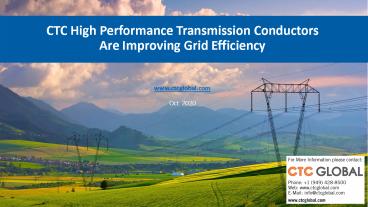High-Performance Transmission Conductor is Improving Grid Efficiency - PowerPoint PPT Presentation
Title:
High-Performance Transmission Conductor is Improving Grid Efficiency
Description:
CTC Global’s ACCC conductor is cost-effectively helping improve grid efficiency and learn why it may be one of the least expensive means of reducing CO2 and other GHG emissions – PowerPoint PPT presentation
Number of Views:25
Title: High-Performance Transmission Conductor is Improving Grid Efficiency
1
CTC High Performance Transmission Conductors Are
Improving Grid Efficiency
www.ctcglobal.com
Oct 2020
2
Introduction
- CTC Global is an ACCC conductor
manufacturing company that was founded to
develop, certify and deploy advanced technologies
to improve the efficiency, capacity, reliability
and resiliency of the electric power grid. - Our primary product is high-capacity, low-sag
CTC Global ACCC Conductor solutions.
www.ctcglobal.com
3
CTC the electric power transmission business
- Most of us associate the word efficiency with
improvements in generation equipment,
transformers and demand side appliances. - While new more efficient components in many cases
are more expensive than the less efficient units
they replace, their higher prices have generally
been easy to justify due to their reduced
operating and lifecycle costs.
www.ctcglobal.com
4
Smart Grid Strategy
- Smart Grid strategy was developed to help
decrease peak load demand by shifting certain
tasks to off peak hours. Recharging electric
vehicles, being one example. - Whats surprising is how little any of us
actually think about the efficiency of the grid
itself that connects our appliances, homes and
electric cars to generation. Most of the wire
used for this currently consists of aluminum
strands wrapped around a steel core. This wire is
called ACSR (Aluminum Conductor Steel
Reinforced) and the technology is more than 100
years old.
www.ctcglobal.com
5
A new conductor design was created
- It was named ACSS (Aluminum Conductor Steel
Supported). Its very similar to ACSR, but the
aluminum strands were pre-annealed in the
factory. This allowed ACSS to operate at higher
temperatures to accommodate increased loads. - The problem with ACSS is that at higher operating
temperatures, line losses climb exponentially.
The other problem is that as the wire heats up
due to electrical resistance, its high
coefficient of thermal expansion causes it to sag
which can lead to sag-trip outages. The major
east coast blackout of 2003, for instance, was
caused by excessive conductor sag.
www.ctcglobal.com
6
To Mitigate Conductor Sag
- In the wake of the major east coast blackout a
number of companies including 3M and Composite
Technology Corporation (now CTC Global)
introduced HCLS (High-Capacity, Low-Sag)
conductors. - The ACCR core is actually a fiber reinforced
aluminum, so its electrical resistance (and
efficiency) is greatly improved over conventional
steel core that offers very poor conductivity.
The CTC Global product ACCC (Aluminum Conductor
Composite Core) uses a non-conductive carbon and
glass fiber core. - Because CTC Globals ACCC core is so much lighter
than steel, the design incorporates an additional
28 percent more aluminum without a weight or
diameter penalty. The added aluminum content (and
improved quality) serves to lower electrical
resistance and therefore effectively reduces line
losses by 25 to 40 percent or more compared to
steel reinforced alternatives.
www.ctcglobal.com
7
While many leading executives have stated
- Its cheaper to save a Nega Watt than it is to
produce a Mega Watt, in the case of delivering
power, this is also very true. To put this in
even greater perspective, a CO2 reduction of
80,000 Metric Tons is the equivalent of removing
nearly 17,000 cars from the road. - If you clip this down into a one-mile section,
that will equate to a CO2 reduction of 667 Metric
Tons or a reduction of 140 cars per mile.
Assuming a reconductoring cost of 300,000 per
mile, this would equate to a one-time cost of
450 per Metric Ton using a high-performance
conductor. Though things are changing quickly,
the feds currently offer a 7,500 rebate for
purchasers of electric cars. That equates to a
government investment of 1,579 to save one
Metric Ton of CO2 not including the cost of the
car on top of it.
www.ctcglobal.com
8
Contact Us
- Website www.ctcglobal.com
- Phone 1 949 428 8500
- Fax 1 949 428 8515
- Email info_at_ctcglobal.com
- Thank You































